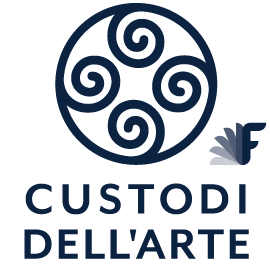

Piazza Pisacane and the statue of Garibaldi
Piazza Pisacane and the statue of Garibaldi
Riproduci traccia audio
Play audio track
Audio-Track abspielen
Piazza Pisacane and the statue of Garibaldi
Trascrizione traccia audio
I was born in Viale Roma, in the Monte district of Cesenatico, in 1956. I was the ninth of ten children.
I have always gone on foot around town, from my house to the Piazza della Conserve, the monastery, and this square, which we in Cesenatico have always called Garibaldi square, even though we know very well that it is actually named after Carlo Pisacane.
If you turn, with your back to the statue and look towards the top of the port, you can see a yellow building, which as a child seemed very big to me. That was once Cesenatico’s hospital, and my father worked there as its custodian. It was he who decided who was allowed to enter or not, based on the urgency of their medical needs. He was so familiar with all his fellow citizens that he knew each and everyone’s health conditions in detail.
I was sent to nursery school in Via Mazzini, a school run by nuns, beyond the theatre, on the other side of the port. It was a short journey from my house but crossing the port would take me into a different neighbourhood and from Monte I would travel to the Valona district. During the first few days of school, I fled and returned home secretly, but always with an empty snack box having eaten it on my way.
On my journey home, I would see him, his gaze would never leave me. Even today, when I pass by, alone or in company, I look at him and greet him silently.
This was one of the very first statues in Italy dedicated to Garibaldi. Commissioned in 1884 the sculptor asked the town for an advance payment so he could buy Marble from Carrara and the town managed to meet his request.
To commemorate Garibaldi, we have a festival on the first Sunday of August, simply known locally as “Garibaldi”. It is well-loved and when the date approaches, excitement grows and you continually hear people reminding you “Oh, it’s Garibaldi on Sunday!”
As a child, I have many memories of my father taking me and my sister out on bike rides, but I don’t have many childhood memories of being with my mother as she was always working. However, I distinctly remember the Garibaldi celebrations. She would take off her apron, put on a beautiful dress, comb her hair in front of the mirror and get ready for us all to go out together: This was an important event that she would always attend and never miss!
In the morning a band would march in a procession through the port together with various dignitaries of the town, they would place a laurel wreath in front of the statue. The procession would then continue, towards the sea, along the port, where, in front of the house that looked after Garibaldi’s sick wife, Anita, another wreath would be laid. People would then climb onboard both the fishing boats and the vintage sailing boats. They would form a flotilla and sail out to sea where the last wreath would be thrown on the water.
In the evening the town would be lit up by a firework display. The Piazza Andrea Costa, next to the skyscraper, would be filled with people, watching the thousands of colours, and listening to the explosions of the fireworks! I remember that there were pinwheels of beautiful lights, and the very last one that lit up had the shape of Garibaldi on horseback.
I was a little spectator with my eyes and mouth wide open at the wonder of the sight.
Later, as an adult, working for the town Council, I began to organize the celebrations myself and it would be me getting on the boat with the wreath to be thrown into the sea. One of the nicest things I remember was the arrival of the Garibaldini in their coach. These were a group of Garibaldi’s followers, known as the inseguiti, dressed in traditional costume. They would head the procession through the port, with the band and the citizens walking behind.
They looked like a proud group of leaders, proud to parade through our country.
Garibaldi day is also the same date when we hold a competition called the Palio della Cuccagna, this takes place on the west side of the port. Nowadays there are two and another one takes place in July, but that is more a tourist initiative than anything else. For us locals the August Palio is more important because it is an annual competition between all the districts of Cesenatico, even those that are situated in the immediate countryside.
After parading through the old town, proudly waving their district flags, the teams of the local districts of Bagnarola, Borella, Boschetto, Cannucceto, Il Monte, Ponente, Sala, Valona and Villalta compete to win prizes such as chickens and salamis which hang at the end of a wooden pole. (The prizes nowadays are plastic, but in times gone by real food was hung on the pole!). The 14-meter-long pole is positioned at an angle by the boatyard so that it mainly sits over the water, it is smothered with grease to make it more difficult for the contestants to reach their prize.
Both sides of the port are crowded with people who come to watch this, not just local fans but also many Italians from outside of town and foreign tourists too.
Each participant, encouraged by the crowd, has his own climbing style: there are those who climb on tiptoe using their nails as a foothold, those who try with a bicycle, those who run and before falling remove large quantities of the grease with their hands, thus making it easier for those who will take their turn afterwards, even if they are from another team. A huge competition but all the contenders work together! They fall in the water, and when each contestant resurfaces laughter erupts from the audience. This goes on until one of the contestants finally manages to cling to the wreath adorned with chickens and salami. They are the winner; they win the trophy that next year will have their district’s name engraved on it.
Until we meet again, this time next year Garibaldi!
Audio Track transcription
I was born in Viale Roma, in the Monte district of Cesenatico, in 1956. I was the ninth of ten children.
I have always gone on foot around town, from my house to the Piazza della Conserve, the monastery, and this square, which we in Cesenatico have always called Garibaldi square, even though we know very well that it is actually named after Carlo Pisacane.
If you turn, with your back to the statue and look towards the top of the port, you can see a yellow building, which as a child seemed very big to me. That was once Cesenatico’s hospital, and my father worked there as its custodian. It was he who decided who was allowed to enter or not, based on the urgency of their medical needs. He was so familiar with all his fellow citizens that he knew each and everyone’s health conditions in detail.
I was sent to nursery school in Via Mazzini, a school run by nuns, beyond the theatre, on the other side of the port. It was a short journey from my house but crossing the port would take me into a different neighbourhood and from Monte I would travel to the Valona district. During the first few days of school, I fled and returned home secretly, but always with an empty snack box having eaten it on my way.
On my journey home, I would see him, his gaze would never leave me. Even today, when I pass by, alone or in company, I look at him and greet him silently.
This was one of the very first statues in Italy dedicated to Garibaldi. Commissioned in 1884 the sculptor asked the town for an advance payment so he could buy Marble from Carrara and the town managed to meet his request.
To commemorate Garibaldi, we have a festival on the first Sunday of August, simply known locally as “Garibaldi”. It is well-loved and when the date approaches, excitement grows and you continually hear people reminding you “Oh, it’s Garibaldi on Sunday!”
As a child, I have many memories of my father taking me and my sister out on bike rides, but I don’t have many childhood memories of being with my mother as she was always working. However, I distinctly remember the Garibaldi celebrations. She would take off her apron, put on a beautiful dress, comb her hair in front of the mirror and get ready for us all to go out together: This was an important event that she would always attend and never miss!
In the morning a band would march in a procession through the port together with various dignitaries of the town, they would place a laurel wreath in front of the statue. The procession would then continue, towards the sea, along the port, where, in front of the house that looked after Garibaldi’s sick wife, Anita, another wreath would be laid. People would then climb onboard both the fishing boats and the vintage sailing boats. They would form a flotilla and sail out to sea where the last wreath would be thrown on the water.
In the evening the town would be lit up by a firework display. The Piazza Andrea Costa, next to the skyscraper, would be filled with people, watching the thousands of colours, and listening to the explosions of the fireworks! I remember that there were pinwheels of beautiful lights, and the very last one that lit up had the shape of Garibaldi on horseback.
I was a little spectator with my eyes and mouth wide open at the wonder of the sight.
Later, as an adult, working for the town Council, I began to organize the celebrations myself and it would be me getting on the boat with the wreath to be thrown into the sea. One of the nicest things I remember was the arrival of the Garibaldini in their coach. These were a group of Garibaldi’s followers, known as the inseguiti, dressed in traditional costume. They would head the procession through the port, with the band and the citizens walking behind.
They looked like a proud group of leaders, proud to parade through our country.
Garibaldi day is also the same date when we hold a competition called the Palio della Cuccagna, this takes place on the west side of the port. Nowadays there are two and another one takes place in July, but that is more a tourist initiative than anything else. For us locals the August Palio is more important because it is an annual competition between all the districts of Cesenatico, even those that are situated in the immediate countryside.
After parading through the old town, proudly waving their district flags, the teams of the local districts of Bagnarola, Borella, Boschetto, Cannucceto, Il Monte, Ponente, Sala, Valona and Villalta compete to win prizes such as chickens and salamis which hang at the end of a wooden pole. (The prizes nowadays are plastic, but in times gone by real food was hung on the pole!). The 14-meter-long pole is positioned at an angle by the boatyard so that it mainly sits over the water, it is smothered with grease to make it more difficult for the contestants to reach their prize.
Both sides of the port are crowded with people who come to watch this, not just local fans but also many Italians from outside of town and foreign tourists too.
Each participant, encouraged by the crowd, has his own climbing style: there are those who climb on tiptoe using their nails as a foothold, those who try with a bicycle, those who run and before falling remove large quantities of the grease with their hands, thus making it easier for those who will take their turn afterwards, even if they are from another team. A huge competition but all the contenders work together! They fall in the water, and when each contestant resurfaces laughter erupts from the audience. This goes on until one of the contestants finally manages to cling to the wreath adorned with chickens and salami. They are the winner; they win the trophy that next year will have their district’s name engraved on it.
Until we meet again, this time next year Garibaldi!
Audiotrack-Text
I was born in Viale Roma, in the Monte district of Cesenatico, in 1956. I was the ninth of ten children.
I have always gone on foot around town, from my house to the Piazza della Conserve, the monastery, and this square, which we in Cesenatico have always called Garibaldi square, even though we know very well that it is actually named after Carlo Pisacane.
If you turn, with your back to the statue and look towards the top of the port, you can see a yellow building, which as a child seemed very big to me. That was once Cesenatico’s hospital, and my father worked there as its custodian. It was he who decided who was allowed to enter or not, based on the urgency of their medical needs. He was so familiar with all his fellow citizens that he knew each and everyone’s health conditions in detail.
I was sent to nursery school in Via Mazzini, a school run by nuns, beyond the theatre, on the other side of the port. It was a short journey from my house but crossing the port would take me into a different neighbourhood and from Monte I would travel to the Valona district. During the first few days of school, I fled and returned home secretly, but always with an empty snack box having eaten it on my way.
On my journey home, I would see him, his gaze would never leave me. Even today, when I pass by, alone or in company, I look at him and greet him silently.
This was one of the very first statues in Italy dedicated to Garibaldi. Commissioned in 1884 the sculptor asked the town for an advance payment so he could buy Marble from Carrara and the town managed to meet his request.
To commemorate Garibaldi, we have a festival on the first Sunday of August, simply known locally as “Garibaldi”. It is well-loved and when the date approaches, excitement grows and you continually hear people reminding you “Oh, it’s Garibaldi on Sunday!”
As a child, I have many memories of my father taking me and my sister out on bike rides, but I don’t have many childhood memories of being with my mother as she was always working. However, I distinctly remember the Garibaldi celebrations. She would take off her apron, put on a beautiful dress, comb her hair in front of the mirror and get ready for us all to go out together: This was an important event that she would always attend and never miss!
In the morning a band would march in a procession through the port together with various dignitaries of the town, they would place a laurel wreath in front of the statue. The procession would then continue, towards the sea, along the port, where, in front of the house that looked after Garibaldi’s sick wife, Anita, another wreath would be laid. People would then climb onboard both the fishing boats and the vintage sailing boats. They would form a flotilla and sail out to sea where the last wreath would be thrown on the water.
In the evening the town would be lit up by a firework display. The Piazza Andrea Costa, next to the skyscraper, would be filled with people, watching the thousands of colours, and listening to the explosions of the fireworks! I remember that there were pinwheels of beautiful lights, and the very last one that lit up had the shape of Garibaldi on horseback.
I was a little spectator with my eyes and mouth wide open at the wonder of the sight.
Later, as an adult, working for the town Council, I began to organize the celebrations myself and it would be me getting on the boat with the wreath to be thrown into the sea. One of the nicest things I remember was the arrival of the Garibaldini in their coach. These were a group of Garibaldi’s followers, known as the inseguiti, dressed in traditional costume. They would head the procession through the port, with the band and the citizens walking behind.
They looked like a proud group of leaders, proud to parade through our country.
Garibaldi day is also the same date when we hold a competition called the Palio della Cuccagna, this takes place on the west side of the port. Nowadays there are two and another one takes place in July, but that is more a tourist initiative than anything else. For us locals the August Palio is more important because it is an annual competition between all the districts of Cesenatico, even those that are situated in the immediate countryside.
After parading through the old town, proudly waving their district flags, the teams of the local districts of Bagnarola, Borella, Boschetto, Cannucceto, Il Monte, Ponente, Sala, Valona and Villalta compete to win prizes such as chickens and salamis which hang at the end of a wooden pole. (The prizes nowadays are plastic, but in times gone by real food was hung on the pole!). The 14-meter-long pole is positioned at an angle by the boatyard so that it mainly sits over the water, it is smothered with grease to make it more difficult for the contestants to reach their prize.
Both sides of the port are crowded with people who come to watch this, not just local fans but also many Italians from outside of town and foreign tourists too.
Each participant, encouraged by the crowd, has his own climbing style: there are those who climb on tiptoe using their nails as a foothold, those who try with a bicycle, those who run and before falling remove large quantities of the grease with their hands, thus making it easier for those who will take their turn afterwards, even if they are from another team. A huge competition but all the contenders work together! They fall in the water, and when each contestant resurfaces laughter erupts from the audience. This goes on until one of the contestants finally manages to cling to the wreath adorned with chickens and salami. They are the winner; they win the trophy that next year will have their district’s name engraved on it.
Until we meet again, this time next year Garibaldi!
Narrato da
Narrated by
Mehr Infos



